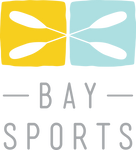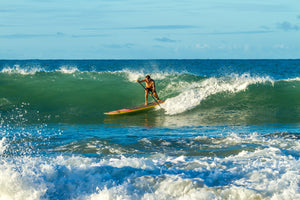How to Catch a Wave on Your Stand Up Paddle Board
Sep 16, 2019
Now you’ve nailed your stand up paddle boarding basics, what’s next? The next stage for many is to take to the surf. But how do you pick the right day, choose the right spot, and ride a wave? This guide takes you through hints and tips to catch your first wave on a paddleboard.
You can give surfing with your paddle board a go fairly early on in your SUP career, but ensure that you’re standing up and paddling confidently before you try.
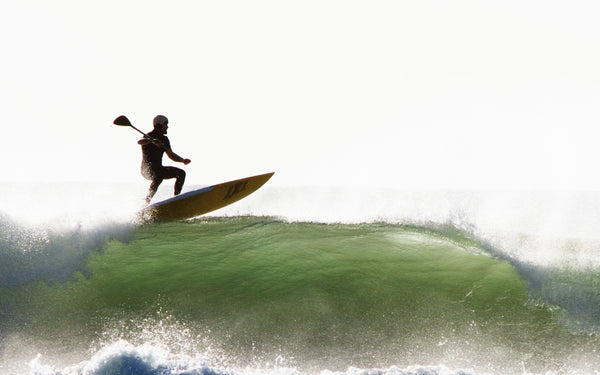
Pick your day
The type of waves you’re looking for when SUPing are different from surfing conditions. When you’re starting out, look for knee to shoulder height waves breaking slowly, and for days that aren’t too windy. Windy days can make it harder to see the waves and also reduce their quality. Avoid waves that are breaking quickly in shallow water.
Pick the right spot
First things first when picking your spot: until you’re confidently riding waves, follow the code of conduct and stay away from other surfers. Keep clear of groups of surfers sitting on clear peaks when you’re a beginner.
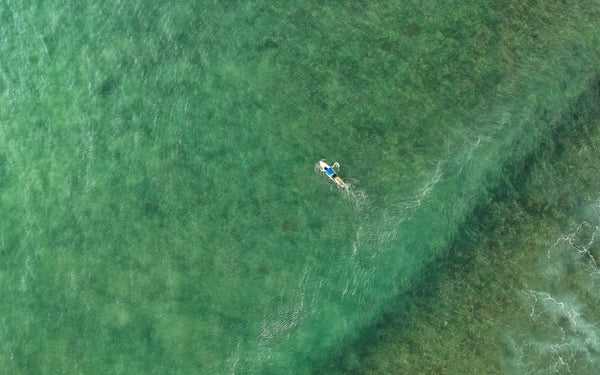
Give yourself plenty of room and stay away from other surfers when starting out
On days with smaller waves, paddling where the unbroken waves are is relatively easy. This ‘out back’ position is good for catching your first wave.
Hold up, what’s ‘out back’?
The more you surf with your paddle board, the more of a feel you’ll get for where ‘out back’ is. You’ll be beyond where a majority of the waves are breaking, and just outside of the larger groups of waves that come in every few minutes – also known as ‘set waves’.
You’re better off being too far out than too far in when you’re starting out because you can work your way in when you get a feel for the waves.
Approaching your wave
So, how do you get ‘out back’ to catch your first wave? Getting through the waves can be challenging if you’re used to paddling in flat water. Try the following:
- Wade out until you’re in chest-deep water, then start paddling with your arms while lying on your board;
- Rest your paddle on your board, holding it under your chest, with the handle over the nose of the board, while you paddle;
- When approaching a wave, lift your body up onto your arms, ensuring that you keep the paddle secure on the board. In this position, you can allow the board to travel over the top of the wave, while some of it passes between you and the board.
Choosing and catching the wave
Next up, you need to choose the right wave for you. Waves come in sets, so you’ll have a choice. Ultimately, which wave to pick comes down to your timing – you need to catch the wave before it breaks. But don’t go too early because it won’t pick you up.
After choosing your wave, paddle at a 90-degree angle to it with a staggered stance – this will help you to maintain your balance. A staggered stance is partway between a traditional paddle board parrallel stance, and a full surf stance. Think one foot at the centre of the board and the other, just slightly off towards the back of the board.
Keep paddling hard, using whatever paddle technique works best for you, towards the beach. This will help you to travel at a similar speed to the wave when it reaches you – you’ll struggle to catch a wave without this speed.
Ensure that your knees stay bent with weight towards the front of the board. Once you’ve caught the wave, you can shift into a complete surf stance.
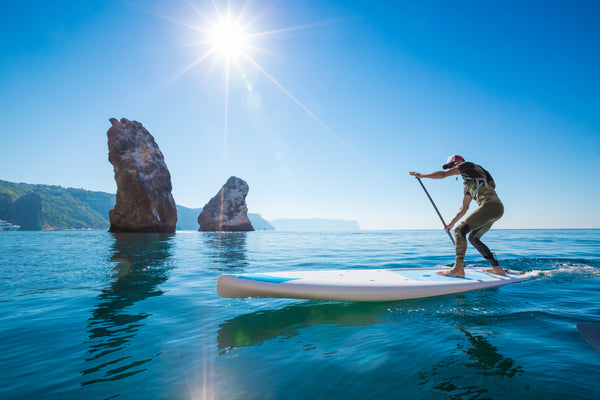
Surf stance on a stand up paddle board
How do I know that I did it?
There will be an obvious moment when the wave is powering your board, rather than your paddling. This can be a new and strange sensation, but you’ll learn to anticipate it in time. Don’t forget to shift to surf stance when the wave takes you.
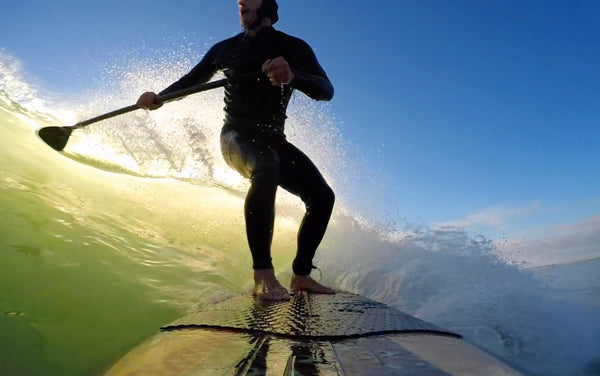
Once the wave takes you, shift to a full surf stance
Why use a SUP rather than a surfboard?
You may be wondering why you’d use a paddle board to ride waves rather than a surfboard. We’re probably biased, but there are many benefits of surfing with a paddle board instead of a surfboard:
- Ease SUPing is one of the easiest ways to surf. Anyone can stand up on a paddle board, and you can moderate how hard you work. If you can stand on a SUP board, then you can likely surf on one too. No matter your age or injuries, it is more accessible than surfing which requires you to quickly push yourself up to standing while catching the wave
- Stability Despite a paddle board being heavier and sturdier than a surfboard, it’s this stability that makes increased mobility possible. Using a paddle rather than your arms to move through the water is much easier and catching a wave is more easily attainable
- Versatility Paddle boards are larger than surfboards, allowing for greater versatility. From fishing to yoga, you can use your board for more than just catching waves, unlike a traditional surfboard. You can also paddle in many different environments – a paddle board can take you places a surfboard can’t
- Work out Yes, surfing is a workout in its own right, but you spend a lot of time sitting waiting for a wave. SUPing requires more stamina, with greater energy exerted on the water.
- Enjoy the view Standing up rather than lying down on your board, which surfers spend a lot of time doing, gives you a much better view of the ocean and your surroundings. You can connect with the environment in a greater way

Take advantage of the view by hitting the surf on your SUP
Top tips
So, when deciding to take to the surf with your paddle board, remember our top tips:
- Pick your day Look for the days with slower-moving waves, and that aren’t too windy
- Find your wave Get ‘out back’ and choose your wave based on timing – you need to catch the wave before it breaks
- Paddle hard Make sure you’re paddling hard towards the beach before the wave reaches you
- Feet and knees positioning Start in a staggered stance while paddling, before moving to a more classic surfing stance when the wave reaches you.
It will take practice to get used to riding waves on your SUP board. Don’t get disheartened and enjoy the surf!
Looking for the perfect surf SUP? Check out our 8’10” RIDER
Want a more of an all-rounder board? Shop our full range of STAND UP PADDLE BOARDS HERE and find your perfect surf partner!
